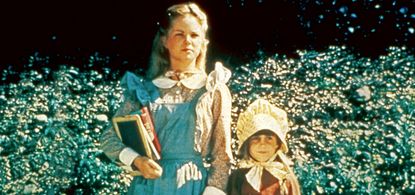Is the prairie dress anti-feminist?
Long billowing sleeves and high necklines are making a comeback. What's a feminist to think?


Fashion trends are notoriously cyclical — if it's happened once, for better or worse, it will happen again. Case in point: In recent months, trend reporters from The New York Times and The Washington Post have foretold the return of the homely prairie dress — that patterned, cotton, mid-to-ankle-length garment with embellishments such as ruffles, puff-sleeves, and high collars, often worn by women in the mid-19th century. If you're struggling to conjure a visual, think Little House on the Prairie, or, if you're a millennial, Westworld (sort of). These dresses are undeniably conservative, covering nearly every inch of the female body.
Having been the young owner of my very own Gunne Sax prairie dress back in the late '70s/early '80s, I reflexively shook my head at this news, mainly because the timing seemed off. This is a pivotal moment to be female: More than 100 women were just elected to the House of Representatives; the #TimesUp and #metoo movements continue to gain momentum; women are reclaiming the female gaze amid the threat of a long calculated Roe v. Wade reversal. This is a time to unequivocally demand equality on any and all fronts, including in fashion. I wondered: Why on Earth is a trend that seems so regressive suddenly en vogue?
Let's first examine this garment's history. During westward expansion, prairie dresses were considered practical and functional, says Olivia Warschaw, fashion and textile design librarian at The New School. "Women were moving west with clothes they were expected to be able to travel and work in," she says. "Because these women were moving far away from city centers, they were less able to acquire fabric for new garments. Cotton is breathable, inexpensive, easily washed, and hides alteration well. And, many women would include gathers or pleats in their dresses to have extra fabric for alterations when their bodies changed. Rather than purchasing new dresses in new styles, some women would alter older dresses to have aspects of multiple trends."
Subscribe to The Week
Escape your echo chamber. Get the facts behind the news, plus analysis from multiple perspectives.

Sign up for The Week's Free Newsletters
From our morning news briefing to a weekly Good News Newsletter, get the best of The Week delivered directly to your inbox.
From our morning news briefing to a weekly Good News Newsletter, get the best of The Week delivered directly to your inbox.
So in a way, the prairie dress was sort of the equivalent of jeans, at a time when women couldn't wear jeans.
It was during the '70s, around the time Little House was popular, that the prairie dress first resurfaced. At the time, women's disco fashion was comprised of hot pants and plunging necklines, seeming to celebrate our hard-earned sexual liberation and freedom. In contrast, the prairie dress brought back billowy sleeves, lace accents, and high lace necklines. The leading prairie dress purveyors of that time were called Gunne Sax (aforementioned, by designer Jessica McClintock) and Laura Ashley. Reportedly, McClintock was inspired by the late '60s boho girls she saw floating around San Francisco.
Today, those wearing the prairie dress seem to be trying to reclaim the style under a feminist guise.
Poet/musician Florence Welch, of Florence and the Machine floats ethereally about the stage wearing a version of the prairie dress fashioned by a brand called The Vampire's Wife, founded by Susie Cave (wife of goth-y auteur Nick Cave). Using flamboyant fabric and a little goth sensibility, Cave has managed to sass up the prairie dress into something au courant.
Sign up for Today's Best Articles in your inbox
A free daily email with the biggest news stories of the day – and the best features from TheWeek.com
Those who favor another prairie dress designer, Batsheva Hay, tend to wear her lengthy, modest ruffled creations with Doc Martens. She told The New York Times that, by wearing her designs, some of her fans are "being feminist and radical."
But I'm still struggling to reconcile this look as feminist. Why, after all we've been through, would women choose to cover up so modestly when we're still fighting so long and so hard to be and look however we want?
Interestingly enough, Warschaw, and the leading purveyors of the prairie dress market, don't regard the prairie dress as a vehicle of stylish repression — they regard it as a way to own their femininity by celebrating it.
"I don't think that hyperfeminine aesthetics are antithetical with feminism; rather, feminism allows women to express themselves in a way that makes them most comfortable," Warschaw explains. "One of the large similarities between the prairie dress trend of the '70s and '80s and the current trend is that they correspond with feminist movements."
Warschaw also points out that the original prairie-dressed Western women were making strides as pioneers. "Contrary to popular belief, in the mid-19th century, women in western states like Utah and Wyoming had more rights than women in the eastern U.S. Wyoming was the first state to give votes to women in 1869, and multiple states allowed women to own land, businesses, and work in government," she explains.
So maybe I had it backwards. Maybe this trend isn't necessarily regressive, but progressive — a way to embrace and express a proud femininity.
This observation tosses me back to square one. I'm still a bit disappointed. But perhaps, as with all matters to do with feminism, it's two steps forward, one step back.
Create an account with the same email registered to your subscription to unlock access.
Vivian Manning-Schaffel is a journalist, essayist, creative writer, and editor. Her writing has been featured in NBC News BETTER, Medium, Lenny Letter, The New York Times, and many other additional outlets. Find her online at her website and on Twitter at @VeeManningS and @SoapboxDirty.
-
 Today's political cartoons - April 21, 2024
Today's political cartoons - April 21, 2024Cartoons Sunday's cartoons - devilish decrees, biblical blunders, and more
By The Week US Published
-
 5 carefully selected cartoons about the Trump-Daniels jury selection process
5 carefully selected cartoons about the Trump-Daniels jury selection processCartoons Artists take on a stress-free life, rare peers, and more
By The Week US Published
-
 Loire Valley Lodges review: sleep, feast and revive in treetop luxury
Loire Valley Lodges review: sleep, feast and revive in treetop luxuryThe Week Recommends Forest hideaway offers chance to relax and reset in Michelin key-winning comfort
By Julia O'Driscoll, The Week UK Published